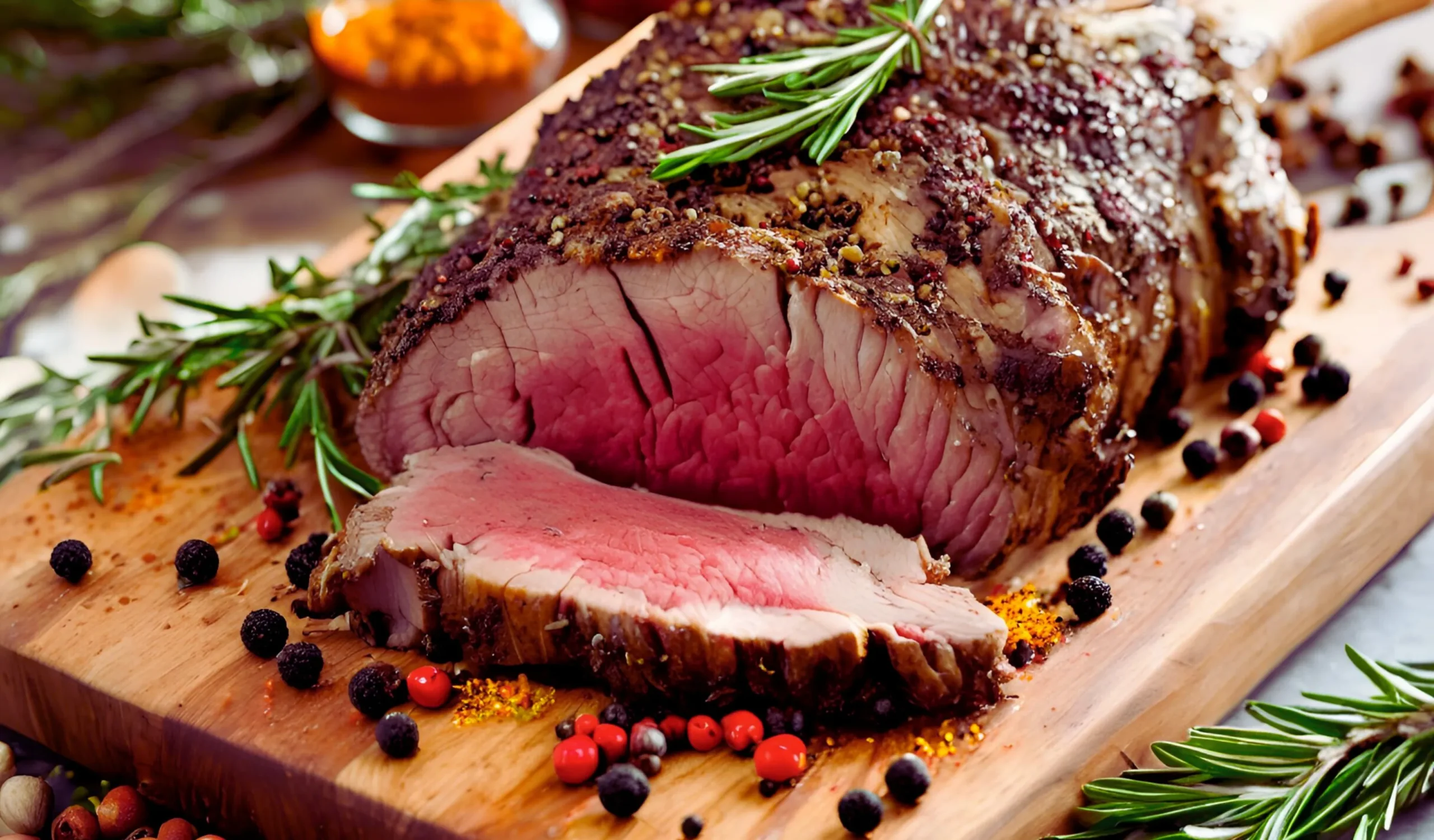Prime Rib Rub Recipe: Perfect Seasoning for Your Roast
When it comes to cooking prime rib, the secret lies in the seasoning. A well-made rub elevates the flavor, bringing out the richness of the meat while creating a crust that’s simply irresistible. This article will guide you through crafting the perfect prime rib rub recipe, from understanding the ingredients to mastering the application techniques. Whether you’re a seasoned chef or a beginner in the kitchen, this comprehensive guide has you covered.
Part 1: Introduction to Prime Rib Rubs
What is a Prime Rib Rub?
A Prime Rib Rub Recipe is a mix of carefully chosen spices, herbs, and seasonings designed to enhance the natural flavors of the meat. Unlike marinades, which penetrate deeply into the meat, rubs create a flavorful crust on the surface, adding texture and complexity to each bite.
The beauty of a Prime Rib Rub Recipe lies in its versatility. You can create a blend that’s spicy, savory, or even slightly sweet, depending on your taste. From the earthy aroma of rosemary to the smoky heat of paprika, this rub transforms a simple roast into a culinary masterpiece. It’s no wonder that prime rib rub recipes have become staples in both home kitchens and professional restaurants.
History and Tradition of Prime Rib Seasoning
The tradition of seasoning meats dates back centuries. In ancient times, salt was not only a flavor enhancer but also a preservative, making it an essential ingredient in cooking. As trade routes expanded, spices like pepper, garlic, and paprika found their way into kitchens around the world, enriching traditional recipes.
When it comes to prime rib, seasoning holds a special place. In many cultures, this luxurious cut of meat is reserved for celebrations and holidays. The rub, therefore, becomes a crucial element, turning the dish into a centerpiece of the feast. Today, the evolution of prime rib rubs reflects global influences, combining ingredients from various cuisines to suit modern palates.
Prime rib rubs continue to be a cornerstone of great roasts, cherished for their ability to turn a simple meal into an unforgettable experience.
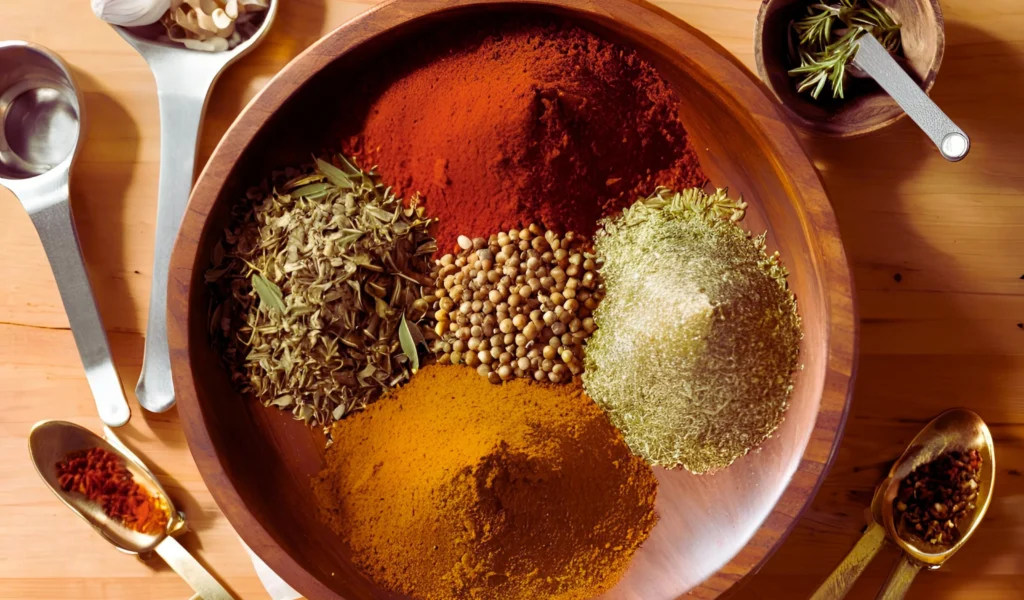
Part 2: Understanding Prime Rib

What is Prime Rib?
The prime rib, often referred to as a standing rib roast, is a premium cut of beef that comes from the primal rib section of the cow. Known for its rich marbling and tender texture, this cut is prized for its robust flavor and juicy bite. A true prime rib roast typically includes the bone, which adds depth to the meat’s flavor during cooking.
Many people confuse prime rib with other cuts like the ribeye. While they both come from the same section, the ribeye is a boneless steak cut from the prime rib roast. Prime rib, on the other hand, is larger, often bone-in, and cooked as a roast rather than individual steaks. Its unique characteristics make it a standout choice for special occasions or festive dinners.
Selecting the Perfect Prime Rib Roast
Choosing the right prime rib is essential for a stellar dish. Start by looking for meat labeled “Prime” by the USDA, as this grade has superior marbling, resulting in a more tender and flavorful roast. If “Prime” isn’t available, “Choice” grade is also a good option for quality.
Pay attention to the marbling, which refers to the white streaks of fat throughout the meat. Marbling melts during cooking, infusing the roast with flavor and ensuring a juicy texture. Additionally, consider the size: a single rib can generally serve two people, so plan accordingly. Opt for a roast with an even thickness and bright, cherry-red coloring for the best results.
Part 3: Components of a Prime Rib Rub
Essential Ingredients for a Prime Rib Rub
Crafting a great prime rib rub starts with selecting the right ingredients. The foundation of most rubs includes kosher salt, coarsely ground black pepper, and garlic powder. These staples provide a balanced base that enhances the natural flavors of the meat.
To add complexity, dried herbs like rosemary and thyme lend an earthy aroma, while smoked paprika introduces a subtle smokiness. A pinch of mustard powder offers a tangy kick, and onion powder rounds out the profile with a hint of sweetness. For those who enjoy a touch of heat, cayenne pepper or chili powder can be added sparingly.
Each ingredient plays a vital role. For example, salt penetrates the meat to amplify its flavor, while sugar in certain rubs can caramelize during cooking, creating a crispy crust. The combination of these elements ensures a rub that’s rich, layered, and perfectly suited for prime rib.
Balancing Flavors: Salt, Sweet, and Heat
Achieving the perfect balance of flavors in a rub is an art. Salt is non-negotiable, as it brings out the meat’s natural essence. However, too much can overpower the dish, so use it wisely. Sweet elements like brown sugar or honey powder can complement the saltiness, adding a subtle sweetness that enhances the crust.
When it comes to heat, spices like cayenne or black pepper should be adjusted based on personal preferences. Some enjoy a bold kick, while others prefer just a hint of spice. It’s all about creating harmony—where no single flavor dominates but instead contributes to a well-rounded profile.
Experimentation is key. Start with small quantities of each ingredient and adjust as needed until you strike the perfect balance for your taste.
Part 4: Crafting the Perfect Prime Rib Rub
Step-by-Step Guide to Making a Prime Rib Rub
Creating a prime rib rub is simple yet rewarding. Follow these steps for a foolproof blend:
- Gather Ingredients: Assemble kosher salt, black pepper, garlic powder, onion powder, dried rosemary, dried thyme, smoked paprika, and mustard powder.
- Measure Precisely: Use measuring spoons to ensure consistent proportions. A typical base mix might include 2 tablespoons of salt, 1 tablespoon of pepper, and 1 teaspoon each of the other ingredients.
- Combine Thoroughly: In a bowl, mix all the ingredients until evenly distributed. Break up any clumps for a smooth consistency.
- Store Correctly: If not using immediately, store the rub in an airtight container in a cool, dark place. It can last for weeks, making it a handy go-to for future roasts.
Customizing Your Rub: Variations and Substitutions
One of the joys of making a rub is the ability to customize it to suit your tastes or dietary needs. For example, swap smoked paprika for regular paprika if you prefer a milder flavor. Fresh herbs can be used instead of dried, though they may need to be applied closer to cooking time to avoid burning.
If you’re exploring international flavors, try incorporating cumin and coriander for a Middle Eastern twist or soy powder and ginger for an Asian-inspired profile. The possibilities are endless, allowing you to tailor the rub to your desired taste while maintaining its essential role in enhancing the prime rib.
Part 5: Applying the Rub to Prime Rib
Preparing the Prime Rib for Seasoning
The first step in seasoning a prime rib is preparation, and it’s crucial to get it right. Begin by trimming excess fat from the roast, leaving a thin layer to enhance flavor during cooking. This ensures the rub penetrates the meat more effectively. Next, pat the prime rib dry with paper towels. Removing moisture is essential for helping the rub adhere and promoting a crispy crust.
Allow the meat to come to room temperature, a step often overlooked but vital for even cooking. A cold roast straight from the fridge may cook unevenly, resulting in an underdone interior or overcooked exterior. Typically, leaving the prime rib out for 1–2 hours is sufficient to ensure consistent results.
Techniques for Applying the Rub
To coat the prime rib evenly, start by rubbing a small amount of olive oil over the surface. This acts as a binder, helping the prime rib rub stick to the meat. Generously sprinkle the rub across the roast, ensuring even coverage. Use your hands to press the rub gently into the meat, working it into every crevice.
If the prime rib has a bone-in structure, don’t forget the sides and underside. For maximum flavor, consider using a coarse grind for your rub ingredients, as this creates a better crust. For those concerned about waste, any excess rub can be collected and used for another roast or even as seasoning for vegetables.
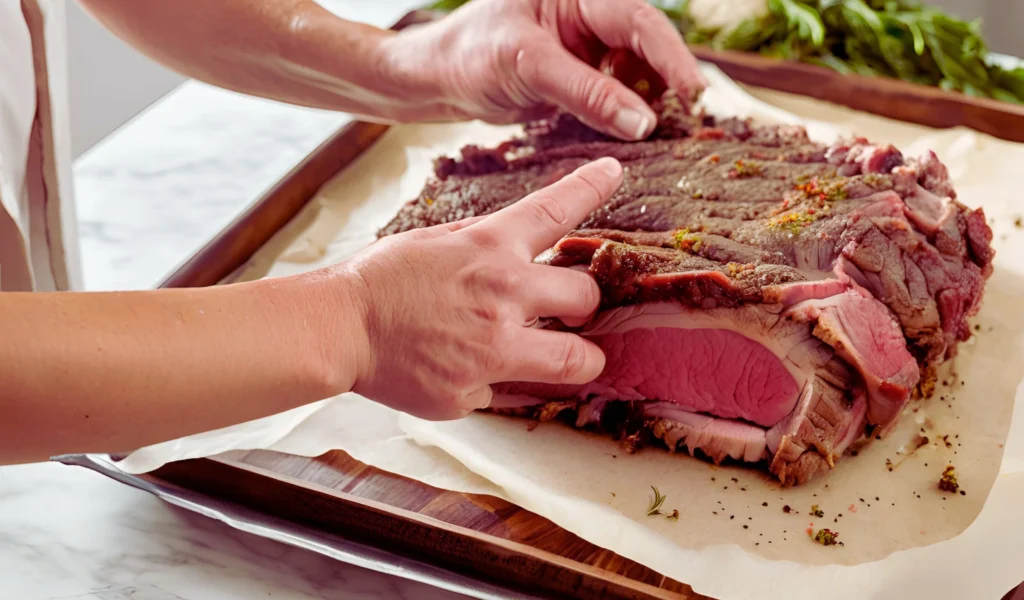
Marinating Time: How Long Should the Rub Sit?
Once the rub is applied, it’s time to let it work its magic. For optimal flavor, allow the seasoned prime rib to sit uncovered in the refrigerator for at least 4 hours. Ideally, overnight marination (12–24 hours) provides the best results, allowing the rub to penetrate the outer layers of the meat deeply.
Short on time? Even 1–2 hours can improve the flavor profile, though the results may be subtler. On the flip side, extended marination (beyond 24 hours) can sometimes overly dry the exterior, so striking a balance is key.
Part 6: Cooking the Seasoned Prime Rib
Cooking Methods: Oven Roasting vs. Grilling
When it comes to cooking a prime rib, oven roasting and grilling are the two most popular methods, each with unique benefits. Oven roasting offers controlled heat, ensuring consistent results. Start with high heat (450°F) to sear the exterior and create a flavorful crust, then reduce to a lower temperature (325°F) for slow, even cooking.
Grilling, on the other hand, imparts a smoky flavor that many find irresistible. Using indirect heat, you can mimic the slow-roasting process while adding a charred, caramelized finish. However, grilling requires more attention to avoid flare-ups and uneven heat distribution.
Both methods deliver excellent results, but the choice ultimately depends on your equipment and flavor preferences. For a more traditional approach, oven roasting is ideal. If you’re looking for a bolder, smoky twist, grilling is the way to go.
Achieving the Desired Doneness
Doneness is a personal preference, and internal temperature is the best guide. For rare meat, aim for 120°F; medium-rare requires 130°F, and medium calls for 140°F. Use a reliable meat thermometer inserted into the thickest part of the roast, avoiding contact with the bone.
Remember, the roast will continue to cook as it rests, often rising 5–10°F. To avoid overcooking, pull the prime rib from heat when it’s 5°F below your target doneness. If grilling, be vigilant about maintaining consistent temperatures to avoid uneven cooking.
Part 7: Serving and Enjoying Prime Rib
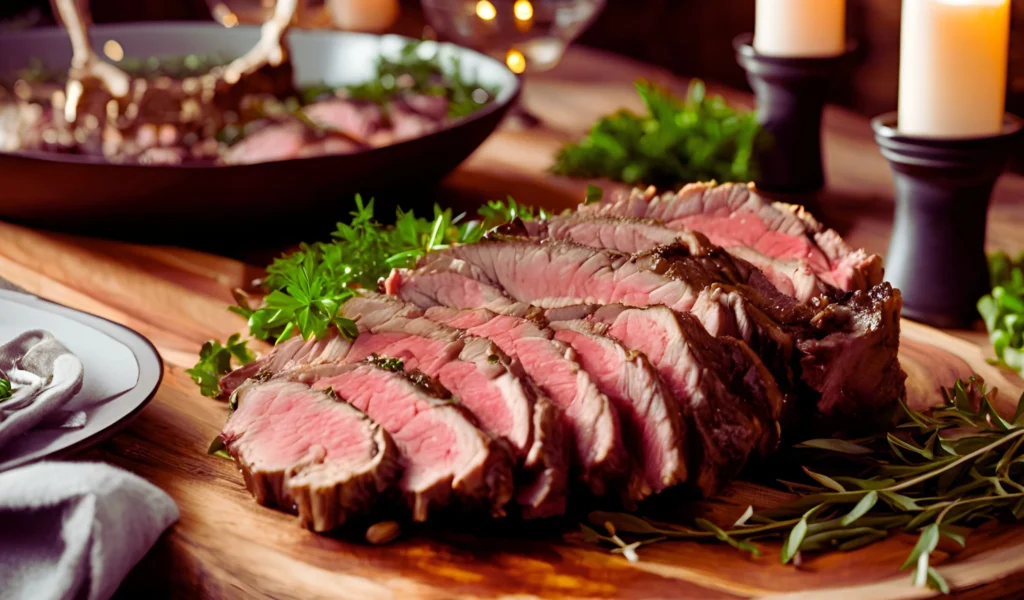
Resting the Meat: Why It’s Crucial
Resting your prime rib after cooking is a non-negotiable step. When meat cooks, its juices move towards the outer layers. Resting allows these juices to redistribute, ensuring a tender and juicy bite throughout. Cover the roast loosely with foil and let it rest for 20–30 minutes before carving.
Carving the Prime Rib
Carving a prime rib requires precision. Begin by removing the rib bones if they’re attached, slicing them away cleanly with a sharp knife. Once the bones are removed, slice the roast against the grain into even portions. This ensures a tender texture in every slice. Aim for ½-inch thick slices for a perfect balance of crust and interior meat.
Suggested Side Dishes and Accompaniments
Pair your prime rib with sides that complement its bold flavors. Garlic mashed potatoes, roasted Brussels sprouts, or a crisp Caesar salad are excellent choices. For condiments, a creamy horseradish sauce or herb-infused butter adds an extra layer of indulgence. Non-alcoholic beverages like sparkling water with citrus or a spiced tea can provide a refreshing counterpoint to the richness of the dish.
Part 8: Prime Rib Rub Recipe
Detailed Prime Rib Rub Recipe
Crafting a rub that perfectly complements your prime rib is simple and satisfying. This recipe strikes the ideal balance between savory, aromatic, and subtly smoky flavors.
Ingredients:
- 2 tablespoons kosher salt
- 2 tablespoons coarsely ground black pepper
- 1 tablespoon garlic powder
- 1 tablespoon onion powder
- 1 tablespoon dried rosemary, crushed
- 1 tablespoon dried thyme
- 1 teaspoon smoked paprika
- 1 teaspoon mustard powder
Instructions:
- In a medium-sized bowl, combine the kosher salt, black pepper, garlic powder, onion powder, dried rosemary, dried thyme, smoked paprika, and mustard powder.
- Mix the ingredients thoroughly until evenly blended. The result should be a vibrant, aromatic mixture.
- Generously apply the rub over the entire surface of the prime rib roast. Use your hands to press the rub into the meat, ensuring it adheres well.
- For best results, place the seasoned roast uncovered in the refrigerator for a minimum of 4 hours. Ideally, leave it overnight to allow the flavors to fully penetrate the meat.
Step-by-Step Cooking Instructions
Once your prime rib is seasoned to perfection, it’s time to cook it to mouthwatering tenderness.
Ingredients:
- 1 prime rib roast (5-6 pounds)
- Prepared prime rib rub
- 2 tablespoons olive oil
Instructions:
- Preheat your oven to 450°F (232°C). This high temperature will help create a beautifully seared crust on the roast.
- Remove the prime rib from the refrigerator and let it sit at room temperature for about 1 hour. This ensures even cooking.
- Pat the roast dry with paper towels to remove excess moisture.
- Rub olive oil evenly over the entire surface of the meat. The oil acts as a binder and helps the rub form a flavorful crust.
- Apply the prepared rub generously, pressing it into the meat for maximum adherence.
- Place the roast on a rack in a roasting pan, fat side up. This positioning allows the fat to baste the meat as it cooks.
- Roast the meat at 450°F for 20 minutes to develop a crust. Then, reduce the oven temperature to 325°F (163°C) and continue roasting. Cook for approximately 15 minutes per pound, or until the internal temperature reaches your desired doneness (120°F for rare, 130°F for medium-rare, and 140°F for medium).
- Once the prime rib reaches the target temperature, remove it from the oven.
- Tent the roast loosely with foil and let it rest for 20–30 minutes. This step allows the juices to redistribute, ensuring every slice is tender and juicy.
Your beautifully cooked prime rib is now ready to serve, complete with a flavorful crust and succulent interior.
Print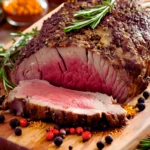
Ultimate Guide to the Perfect Prime Rib Rub Recipe
- Total Time: 4 hours
- Yield: 8 people 1x
- Diet: Gluten Free
Description
A perfectly seasoned prime rib starts with a great rub. This Prime Rib Rub Recipe is a balanced blend of herbs and spices that enhances the meat’s natural flavors, creating a flavorful crust and juicy interior. Whether you’re roasting in the oven or grilling, this rub guarantees a restaurant-quality prime rib every time.
Ingredients
For the Prime Rib Rub:
- 2 tablespoons kosher salt
- 2 tablespoons coarsely ground black pepper
- 1 tablespoon garlic powder
- 1 tablespoon onion powder
- 1 tablespoon dried rosemary, crushed
- 1 tablespoon dried thyme
- 1 teaspoon smoked paprika
- 1 teaspoon mustard powder
For the Prime Rib Roast:
- 1 prime rib roast (5–6 pounds, bone-in or boneless)
- 2 tablespoons olive oil
Instructions
Make the Prime Rib Rub:
- In a small bowl, mix salt, black pepper, garlic powder, onion powder, rosemary, thyme, smoked paprika, and mustard powder.
- Stir until evenly combined. Store in an airtight container if making in advance.
Prepare the Prime Rib:
- Remove the prime rib from the fridge and let it sit at room temperature for 1 hour.
- Pat the roast dry with paper towels.
- Rub olive oil over the entire surface of the meat.
- Generously coat the prime rib with the prepared rub, pressing it into the meat to adhere.
Cooking the Prime Rib (Oven Method):
- Preheat oven to 450°F (232°C).
- Place the prime rib on a rack in a roasting pan, fat side up.
- Roast for 20 minutes at 450°F to develop a crust.
- Reduce the oven temperature to 325°F (163°C).
- Continue roasting for 15 minutes per pound, or until the internal temperature reaches:
- 120°F for rare
- 130°F for medium-rare
- 140°F for medium
- Remove the roast from the oven and tent it loosely with foil.
- Let it rest for 20–30 minutes before slicing to allow juices to redistribute.
Cooking the Prime Rib (Grill Method):
- Preheat your grill to indirect heat (300°F–325°F).
- Place the seasoned prime rib on the cooler side of the grill and cover.
- Cook for 15 minutes per pound, monitoring the internal temperature.
- Once 10°F below your desired doneness, sear over direct heat for 2-3 minutes per side.
- Remove from the grill, rest for 20 minutes, then slice and serve.
Notes
- For a stronger crust: Apply the rub 12-24 hours before cooking and refrigerate uncovered.
- For a smoky twist: Add ½ teaspoon cayenne pepper or chipotle powder to the rub.
- For a milder rub: Reduce black pepper and garlic powder by half.
- Prep Time: 10 minutes
- Cook Time: 15 min per pound
- Category: Main Course
- Method: Grilling
- Cuisine: American
Nutrition
- Serving Size: 6 oz
- Calories: 450 kcal
- Sugar: 0g
- Sodium: 500mg
- Fat: 35g
- Saturated Fat: 15g
- Unsaturated Fat: 18g
- Trans Fat: 0g
- Carbohydrates: 1g
- Fiber: 0.5g
- Protein: 40g
- Cholesterol: 110mg
Keywords: Prime rib rub, steak seasoning, rib roast rub, holiday roast, herb crusted beef, beef rub recipe

